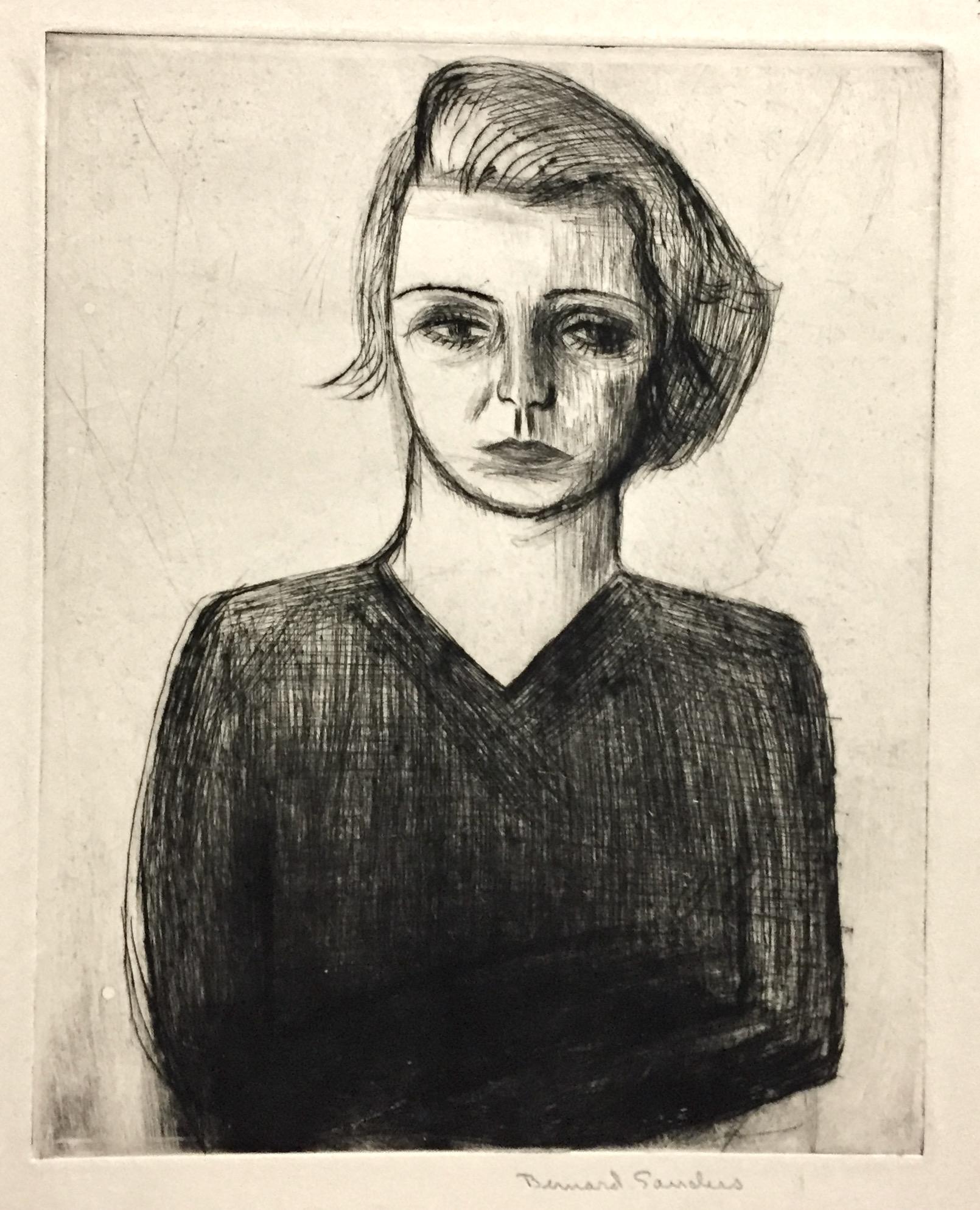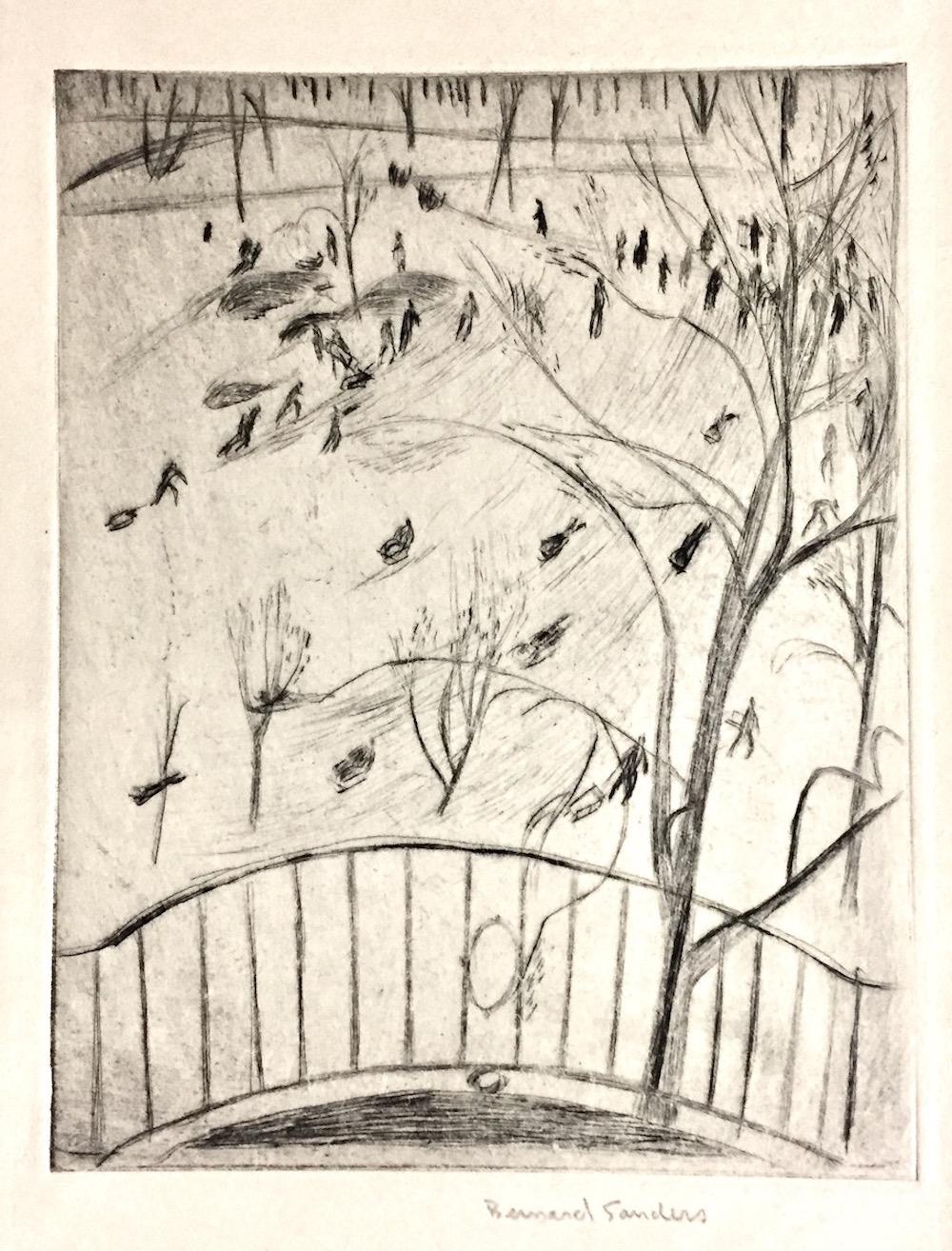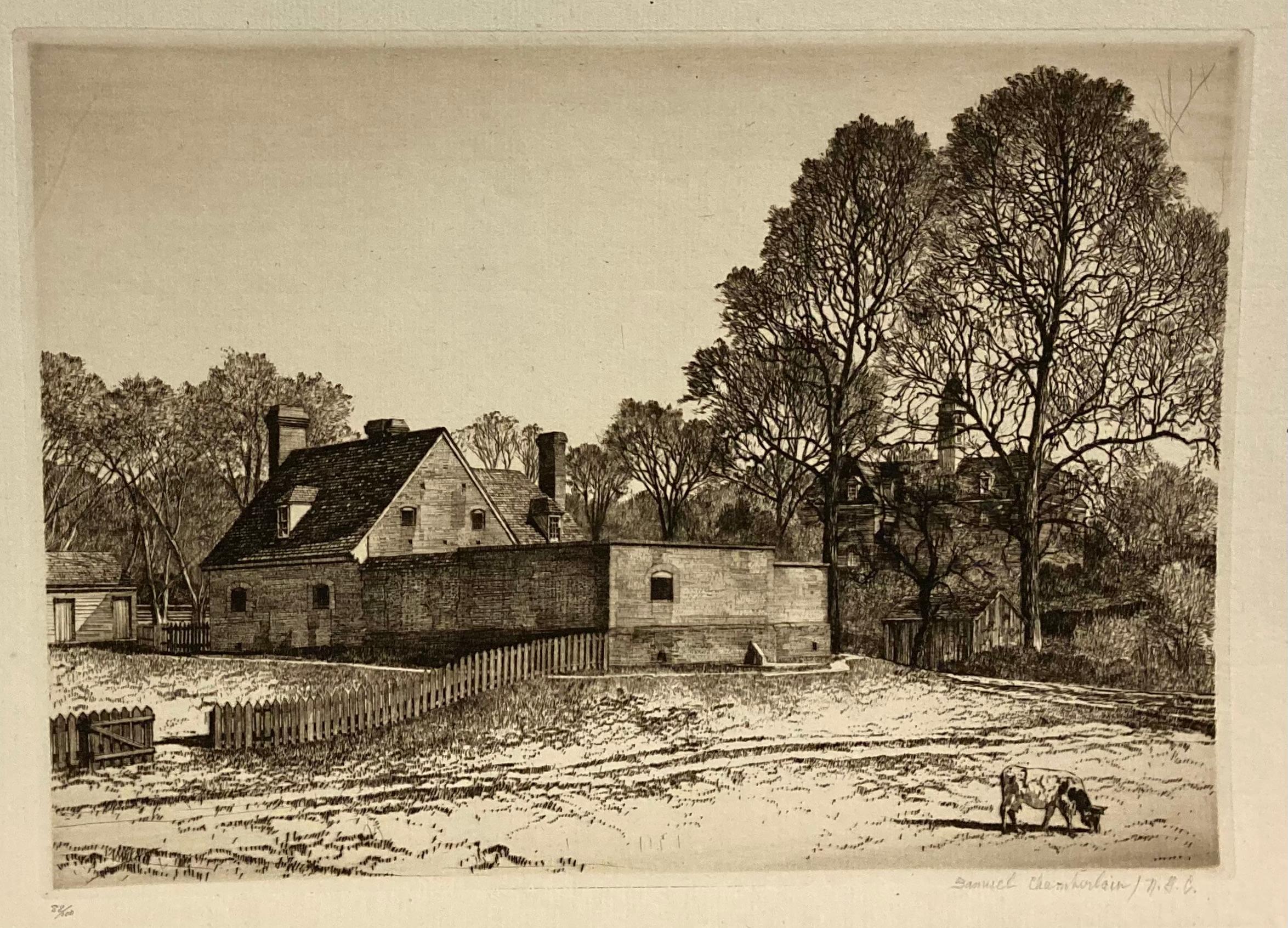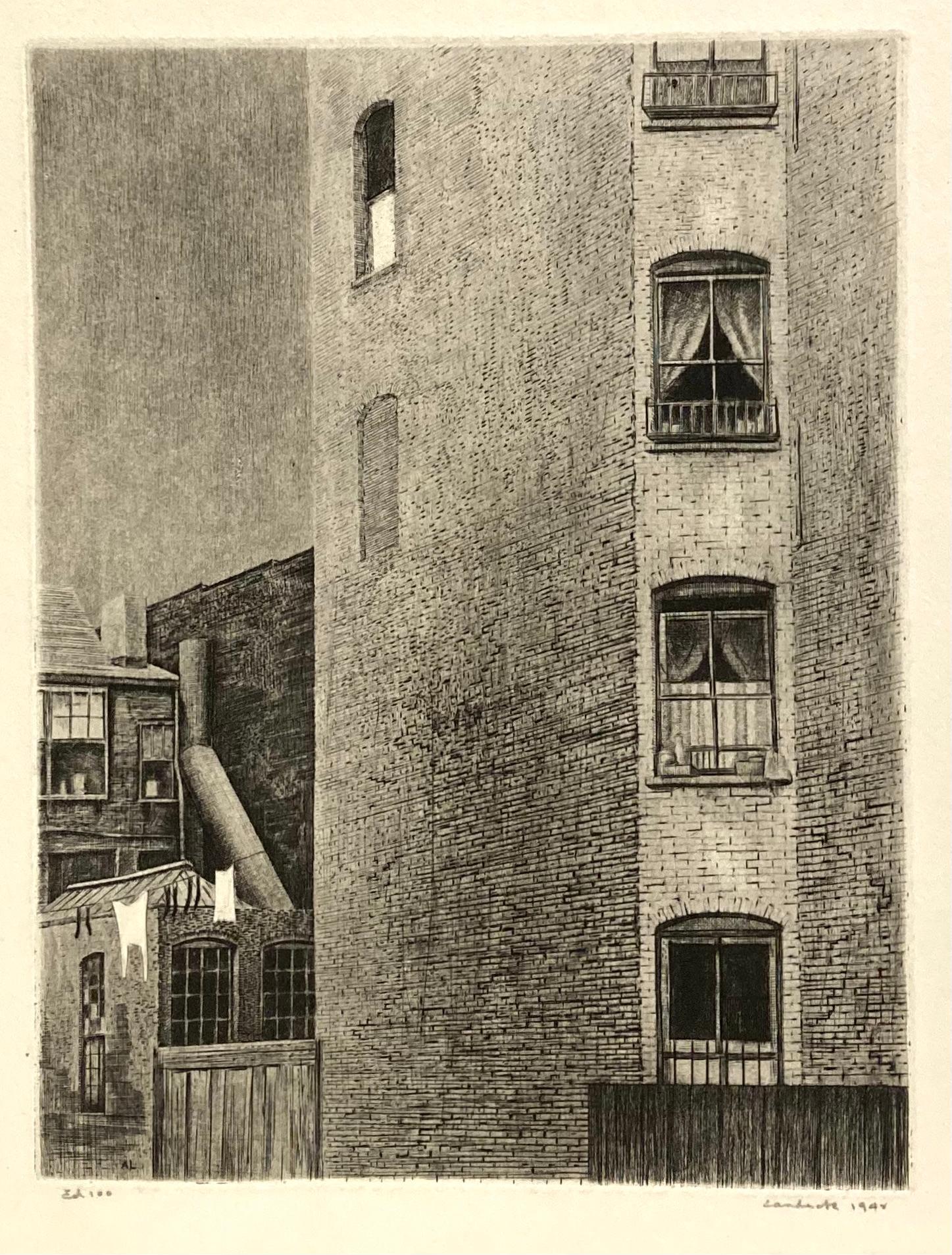Items Similar to Crucifixion
Want more images or videos?
Request additional images or videos from the seller
1 of 10
Ray H. FrenchCrucifixion1947
1947
About the Item
Crucifixion
Engraving, etching, and ground printed in colors, 1947
Signed, titled and numbered in pencil (see photos)
From the second printing by Jon Clemens, master printer in the 1990's
Done while the artist was at the Iowa Print Group, MFA Program, University of Iowa .
Condition: excellent
Image/Plate size: 15 3/4 x 15 3/4 inches
Provenance: Estate of the artist
Printmaker, painter, and sculptor Ray H. French was born in Terre Haute, Indiana on May 16, 1919. Terre Haute was a cultural wasteland before the opening of the Sheldon Swope Art Museum in 1942. Thus, with a father as a coal miner and carpenter, art remained a luxury for Ray. Nevertheless, local art teachers Mabel Mikel Williams and Nola E. Williams helped to foster his creativity and unshakable drive to create things of beauty.
After high school, Ray attended the John Herron School of Art in Indianapolis. His studies there were interrupted by the outbreak of World War II, during which he developed surveillance photographs for the Army Air Force. After the war, Ray transferred to the University of Iowa on the G.I. Bill, where he received both his BFA and MFA degrees. The University of Iowa during the 1940s was a cultural mecca with many major art historians and artists. While in Iowa, Ray played an important role in this culture by becoming a founding member of the Iowa Print Group under Mauricio Lasansky.
Following his graduation in 1948, Ray experienced firsthand the rapid rise in creative printmaking in America. By 1949, he had exhibited at The Brooklyn Museum, the Walker Art Center, and MOMA New York. Ray’s early style of printmaking is characterized by pure line engraving on copper plates, a technique suited perfectly to his study of the beauty of animals. This charming and whimsical subject ran counter to the concurrent trends of Lasansky’s horrors of war and Hayter’s non-objectivity, but was equally effective in capturing the public’s attention. Walruses was purchased by the Victoria and Albert Museum, exhibited at MOMA New York and received the Arthur D. Allen Memorial Purchase Prize for its “skillful and economic use of line.” Shortly thereafter, Ray’s treatment of animals developed further into larger format mixed intaglio prints utilizing hard ground, soft ground, etching, and engraving, as exemplified in The Swan.
By the late 1950s, Ray’s style evolved into organic non-objectivity, in which he incorporated personal autobiographical vignettes and symbolism. His work during this time was further characterized by a departure from the traditional squared compositional format to his cutting and rounding of the plate to accentuate organic shapes. Ray’s 1959 Enchantment remains particularly illustrative of his use of etching and soft ground intaglio. Enchantment was successfully exhibited at the Brooklyn Museum of Art for the 12th National Print Exhibition of The American Federation of the Arts and received the Pennell Purchase Prize from the Library of Congress in 1960.
In the 1960s, Ray also started to focus on blind embossing, which he had first experimented with at the University of Iowa. He was extremely prolific and successful with this medium, selling hundreds of prints in small editions of 10 through the Associated American Artist Gallery in New York. In 1966, Ray built upon his mastery of embossing and began developing a shadow box presentation called a graphic construction that combined color, blind embossing, and multi-layered cutouts to revel intaglio compositions. Noted curator William Lieberman purchased Ray’s masterpiece graphic construction, Moon Rays, on the behalf of MOMA New York and another impression was gifted to the University of Iowa Museum of Art by Alan and Ann January in 2004.
Throughout his artistic career, Ray was also a professor and administrator at DePauw University, which occupied much of his time. Outside of his creative expression, Ray was most proud of his teaching and influencing students to find beauty in their daily lives. Specifically, he was a particularly fervent advocate of printmaking and joined the ranks of many of Lasansky’s students who went on to establish printmaking programs and departments and to further lift the stature of intaglio printmaking. During Ray’s time at DePauw, he received grants to travel around Europe. His yearlong stay in Florence led to a series of etchings, drypoints, and woodcuts of Italian and Etruscan subjects and provided inspiration for many years.
In 1984, Ray retired from his university service to work in a private studio behind his home on DePauw’s campus. After several life threatening illnesses, Ray decided to return to his early creative style of realist depictions of nature and landscape. Eventually, Ray’s health deteriorated further with the onset of macular degeneration. Legally blind, he continued to create art until shortly before his death in 2000 at the age of 80. “Sometimes when I look at a work I create, I am amazed at what inspired it. I ask myself, how on earth did I create this?” said Ray once. Ultimately, this quest to find beauty and create inspiring works of art provided the greatest source of Ray’s happiness and fulfillment, evidenced by the breadth and quality of his artistic legacy.
His work is in over 500 collections including The Museum of Modern Art, the Library of Congress, Metropolitan Museum of Art, the Smithsonian American Art Museum, the Victoria and Albert Museum, the Bibliothèque Nationale, the Brooklyn Museum, the Philadelphia Museum of Art, the Denver Art Museum, the New York Public Library, the Boston Public Library, Midwest Museum of American Art, the Minneapolis Institute of Art, and the Syracuse University Art Galleries.
- Creator:Ray H. French (1919-2000, American)
- Creation Year:1947
- Dimensions:Height: 15.75 in (40.01 cm)Width: 15.75 in (40.01 cm)
- Medium:
- Movement & Style:
- Period:
- Condition:Original. A very rich impression.
- Gallery Location:Fairlawn, OH
- Reference Number:
About the Seller
5.0
Recognized Seller
These prestigious sellers are industry leaders and represent the highest echelon for item quality and design.
Platinum Seller
These expertly vetted sellers are 1stDibs' most experienced sellers and are rated highest by our customers.
Established in 1978
1stDibs seller since 2013
711 sales on 1stDibs
Typical response time: 1 hour
Associations
International Fine Print Dealers Association
- ShippingRetrieving quote...Ships From: Fairlawn , OH
- Return PolicyA return for this item may be initiated within 10 days of delivery.
More From This SellerView All
- On Christmas DayBy Gene KlossLocated in Fairlawn, OHOn Christmas Day Drypoint and aquatint, 1979 Signed lower right: Gene Kloss (see photo) Inscribed lower left: "Artist's Proof", and titled "On Christmas Day" An "artist's proof" imp...Category
1970s American Modern Figurative Prints
MaterialsDrypoint
- Olympian GamesBy Ray H. FrenchLocated in Fairlawn, OHOlympian Games Engraving, 1957 Signed, dated, titled and numbered (see photos) Edition: 25 (7/25) From the first and only edition, probably less than 8 impressions printed Printed by...Category
1950s American Modern Figurative Prints
MaterialsEngraving
- CrucifixionBy Ray H. FrenchLocated in Fairlawn, OHCrucifixion Engraving, 1958 Signed, dated, titled, and annotated 'Printers Proof II' in pencil A printed by Master Printer Jon Clemens, c. 2000 A brilliant impression full of burr Im...Category
1950s American Modern Figurative Prints
MaterialsEngraving
- Profile Bust of a Girl - Woman's Head in Profile (Havard)By Elie NadelmanLocated in Fairlawn, OHProfile Bust of a Girl - Woman's Head in Profile (Havard) Drypoint, 1920 Unsigned (as issued) From: The Drypoints of Elie Nadelman, 21 unpublished prints by the sculptor, proof from ...Category
1920s American Modern Figurative Prints
MaterialsDrypoint
- Girl's Head - Woman's Head (Harvard)By Elie NadelmanLocated in Fairlawn, OHGirl's Head - Woman's Head (Harvard) Drypoint, 1920 Unsigned (as issued) From: The Drypoints of Elie Nadelman, 21 unpublished prints by the sculptor, proof from the original zinc and copper plates, 1952 Published by Curt Valentin, New York Edition: unknown Printed by Charles S. White, master printer Printed on Van Gelder Zonen laid paper with armorial watermark A complete portfolio is in the collection of Harvard Art...Category
1920s American Modern Figurative Prints
MaterialsDrypoint
- Orchestra (or Music)By Adolf DehnLocated in Fairlawn, OHOrchestra (or Music) Lithograph, 1928 Signed, titled and numbered in pencil Edition: 30 This print numbered 15/30 Printed by Edmond Desjobert, Paris Condition: Excellent Provenance: ...Category
1920s American Modern Figurative Prints
MaterialsLithograph
You May Also Like
- Bernard Sanders, (Interior with Five Men)Located in New York, NYThe always fashionable Bernard sanders draws a mysterious spaces with well-dressed gentlemen. Signed in pencil.Category
Early 20th Century American Modern Figurative Prints
MaterialsDrypoint
- Irving Guyer, Christmas Trees on Second Street (NYC)By Irving GuyerLocated in New York, NYPhiladelphia-born Irving Guyer attended the Art Students League and worked in New York City before moving to California. This print is signed and titled i...Category
1930s American Modern Figurative Prints
MaterialsDrypoint, Etching
- Bernard Sanders, Sledding in Central Park, NYCLocated in New York, NYSigned in pencil. This scene is a hundred years old but if we have snow this year it can easily be recreated.Category
Early 20th Century American Modern Landscape Prints
MaterialsDrypoint
- Bernard Sanders, Head of GirlLocated in New York, NYFor a print that's nearly one hundred years old it feels very contemporary. Signed in pencil; titled in lower margin in pencil.Category
Early 20th Century American Modern Interior Prints
MaterialsDrypoint
- Samuel Chamberlain, The Public Gaol, Williamsburg (Virginia)By Samuel ChamberlainLocated in New York, NYSamuel Chamberlain was a superb draftsman and his architectural images are often very complex. This image is, by contrast, quiet and understated: serene to the point of lonely. It's ...Category
1930s American Modern Figurative Prints
MaterialsDrypoint
- Armin Landeck, Tenement WallsBy Armin LandeckLocated in New York, NYThe reference number on this work is Kraeft 88. It's from an edition of 100 and is signed, dated, and numbered, in pencil. Always an intaglio printmaker, Landeck switched from a mor...Category
Mid-20th Century American Modern Figurative Prints
MaterialsDrypoint
Recently Viewed
View AllMore Ways To Browse
Copper Coal Box
Studio Ker
Chalet Canada Art Glass
1930s Pencil Drawing
Braque Etching
Large Plaster Face
Life Is A Banquet
Vedute Di Roma
Chagall Frontispiece
Dc Plate 15
Louis Comfort Tiffany Postage Stamp
Roy Lichtenstein Mirrors Ii
Arnold Herstand
Hiroshige Woodblock
Engraving Of A Woman
Large White Books
Salvador Dali Dreams
Hebrew Judaica





